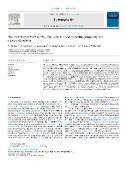The 2020 Samos Mw7 earthquake: Source model depicting complexity and rupture directivity
| dc.contributor.author | Plicka, Vladimír | |
| dc.contributor.author | Gallovič, František | |
| dc.contributor.author | Zahradník, Jiří | |
| dc.contributor.author | Serpetsidaki, A | |
| dc.contributor.author | Sokos, E | |
| dc.contributor.author | Vavlas, N | |
| dc.contributor.author | Kiratzi, A | |
| dc.date.accessioned | 2023-01-23T14:10:40Z | |
| dc.date.available | 2023-01-23T14:10:40Z | |
| dc.date.issued | 2022 | |
| dc.identifier.uri | https://hdl.handle.net/20.500.14178/1671 | |
| dc.description.abstract | The October 30, 2020, Mw7 Samos earthquake ruptured a north-dipping offshore normal fault, bounding the Samos basin; it accommodated-N-S extension and can be viewed as a modern manifestation of the basin evolution. It caused 118 fatalities, generated a tsunami, and caused a co-seismic uplift of 20 to 35 cm of the NW part of Samos Island. Using broadband, strong-motion, and geodetic data, we constrain the location and source geometry of the mainshock. A multiple-point source model suggests three sequential subevents providing 20 s of source duration. Our finite-fault kinematic model confirms the prevalence of large slip amplitudes (-2.4 m) along the entire ruptured area and the up-dip and westward rupture propagation. This directivity is indepen-dently confirmed by Apparent Source Time Functions inferred from regional recordings using a herein developed new variant of the empirical Green's function method. Static GNSS displacements from inland stations yield a near-surface co-seismic slip of-1 m amplitude, contributing to any interpretation of the observed island uplift. The 2020 Samos event showed that in the spatially heterogeneous oblique transtentional regions in the back-arc Aegean region, normal faults bounding the basins are capable to rupture in M7 earthquakes, provoke tsunami generation, and constitute a constant threat to the nearby coastal areas of both Greece and Turkey. | en |
| dc.language.iso | en | |
| dc.relation.url | https://doi.org/10.1016/j.tecto.2022.229591 | |
| dc.rights | Creative Commons Uveďte původ-Neužívejte dílo komerčně-Nezpracovávejte 4.0 International | cs |
| dc.rights | Creative Commons Attribution-NonCommercial-NoDerivativeWorks 4.0 International | en |
| dc.title | The 2020 Samos Mw7 earthquake: Source model depicting complexity and rupture directivity | en |
| dcterms.accessRights | embargoedAccess | |
| dcterms.license | https://creativecommons.org/licenses/by-nc-nd/4.0/legalcode | |
| dc.date.updated | 2023-10-02T06:14:03Z | |
| dc.subject.keyword | Samos | en |
| dc.subject.keyword | Aegean | en |
| dc.subject.keyword | Rupture directivity | en |
| dc.subject.keyword | Earthquake | en |
| dc.subject.keyword | Slip model | en |
| dc.relation.fundingReference | info:eu-repo/grantAgreement/UK/COOP/COOP | |
| dc.date.embargoStartDate | 2023-10-02 | |
| dc.date.embargoEndDate | 2024-10-01 | |
| dc.type.obd | 73 | |
| dc.type.version | info:eu-repo/semantics/acceptedVersion | |
| dc.identifier.doi | 10.1016/j.tecto.2022.229591 | |
| dc.identifier.utWos | 000892625500002 | |
| dc.identifier.eidScopus | 2-s2.0-85140204433 | |
| dc.identifier.obd | 620126 | |
| dc.identifier.riv | RIV/00216208:11320/22:10452467 | |
| dc.subject.rivPrimary | 10000::10500 | |
| dcterms.isPartOf.name | Tectonophysics | |
| dcterms.isPartOf.issn | 0040-1951 | |
| dcterms.isPartOf.journalYear | 2022 | |
| dcterms.isPartOf.journalVolume | 843 | |
| dcterms.isPartOf.journalIssue | October | |
| uk.faculty.primaryId | 116 | |
| uk.faculty.primaryName | Matematicko-fyzikální fakulta | cs |
| uk.faculty.primaryName | Faculty of Mathematics and Physics | en |
| uk.department.primaryId | 1276 | |
| uk.department.primaryName | Katedra geofyziky | cs |
| uk.department.primaryName | Department of Geophysics | en |
| dc.description.pageRange | nestránkováno | |
| dc.type.obdHierarchyCs | ČLÁNEK V ČASOPISU::článek v časopisu::původní článek | cs |
| dc.type.obdHierarchyEn | JOURNAL ARTICLE::journal article::original article | en |
| dc.type.obdHierarchyCode | 73::152::206 | en |
| uk.displayTitle | The 2020 Samos Mw7 earthquake: Source model depicting complexity and rupture directivity | en |

